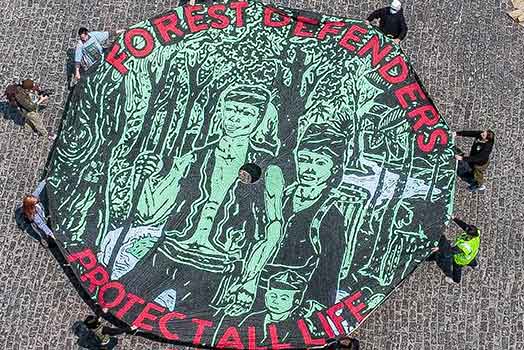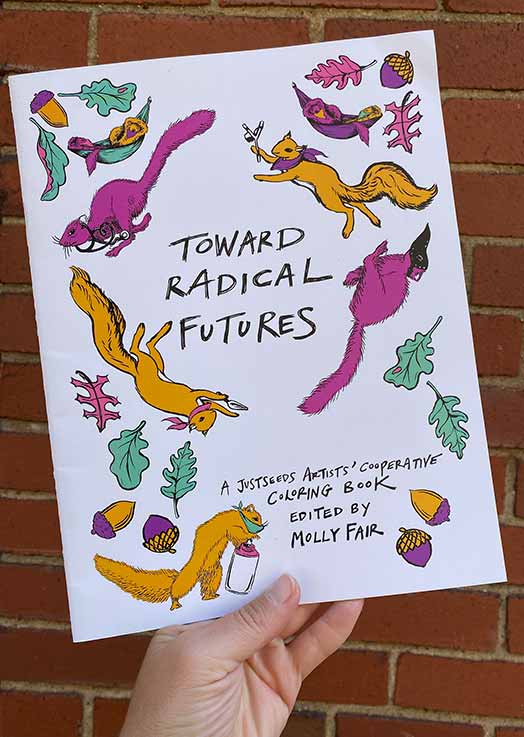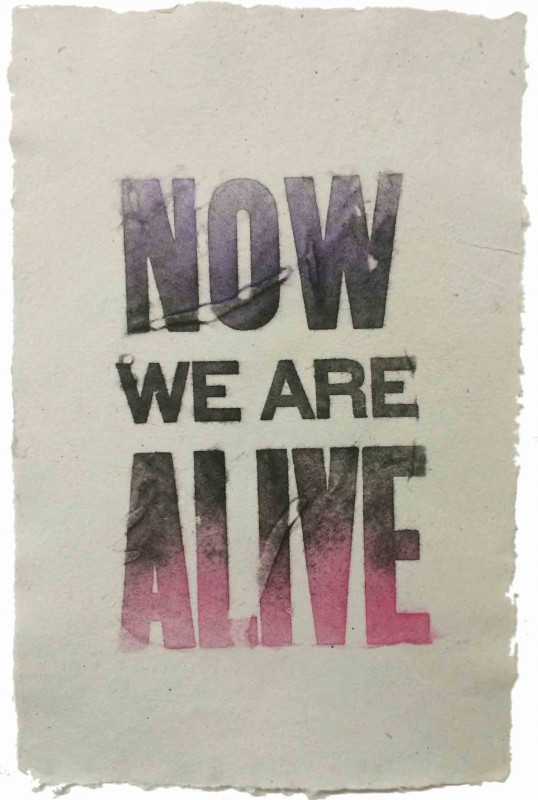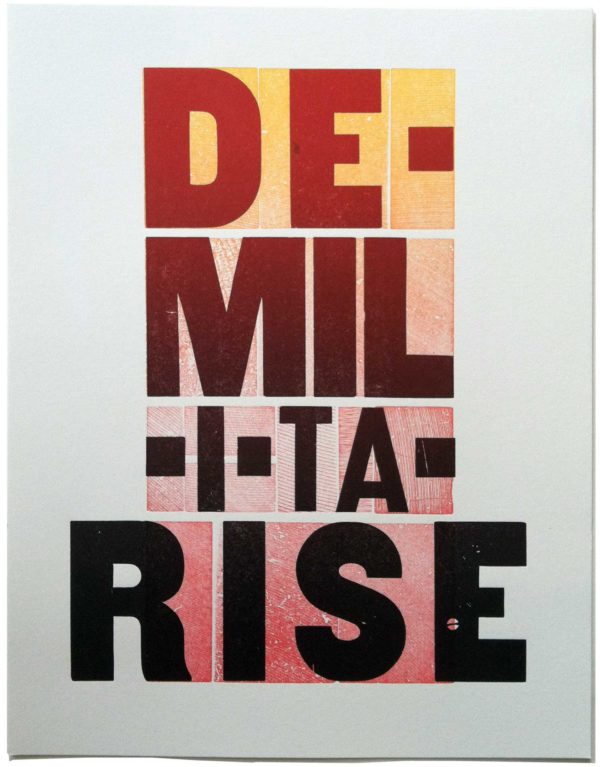
MonicaTrinidad at Do Not Resist exhibition. Photo by Love & Struggle photos.
A growing number of artists have been responding to social issues and making political work. Yet, fewer have been digging in a bit deeper to do the work to integrate their artistic practice into building community, solidarity across communities, and political campaigns. One artists that has been doing just that and is central to a growing Black youth-led movement against police violence in Chicago is Monica Trinidad.
Monica is a queer, Latinx artist and organizer born and raised on the southeast side of Chicago. In 2016, Monica co-founded For the People Artists Collective, a radical squad of Black artists and artists of color in Chicago who create work that uplifts and projects struggle, resistance, and survival within and for our marginalized communities. For the People Artists Collective has been central in the development of #NoCopAcademy an effort supported by community organizations across Chicago, that want to see $95 million invested in our communities rather than a new police training grounds proposed by Mayor Rahm Emanuel for the west side of Chicago. The #NoCopAcademy statement of opposition notes:
Chicago already spends $1.5 billion on police every year—that’s $4 million every single day. We spend 300% more on the CPD as a city than we do on the Departments of Public Health, family and support services, transportation, and planning and development (which handles affordable housing). This plan is being praised as a development opportunity to help local residents around the proposed site, but when Rahm closed 50 schools in 2013, six were in this neighborhood. The message is clear: Rahm supports schools and resources for cops, not for Black and Brown kids.
We demand a redirecting of this $95 million into Chicago’s most marginalized communities instead. Real community safety comes from fully-funded schools and mental health centers, robust after-school and job- training programs, and social and economic justice. We want investment in our communities, not expanded resources for police.
After seeing 95 Million For?, a pop up exhibition at Art In These Times that Monica curated in conjunction with #NoCopAcademy, I reached out to Monica to talk with her about For the People Artists Collective, #NoCopAcademy, and her thoughts about the relationship between art and people’s movements.

Posters designed for 95 Million For? by Miguel Lopez, Jes Scheinpflug, and Chiara Galimberti
Available for download here
Aaron Hughes (AH): In your words what is the NoCopAcademy campaign and why is it important for you and For the People Artists Collective to be involved with the campaign?
Monica Trinidad (MT): The #NoCopAcademy campaign is an intergenerational, multiracial, Black youth-led effort to stop the construction of a $95 million dollar police academy in West Garfield Park. Over 55 organizations are involved in this effort, calling for more funding for schools and refusing any expansion of policing in Chicago. For the People Artists Collective has been involved from the very beginning, from helping to develop the hashtag #NoCopAcademy, to hosting art builds with community members and endorsing organizations where we created buttons, t-shirts, posters, and zines to illuminate and amplify the campaign. Both art and culture, and following the leadership of Black youth were deemed indispensable from day one, which I think really speaks to the level of success this campaign has had so far.
AH: Even though the campaign was just getting started, you and For the People Artists Collective thought it was important to do a call out to other artists for the 95 Million For? pop up exhibition at Art In These Times. Why was it important to get other artists involved?
MT: The call for artists went out literally a day after we launched the campaign, and we saw it as a way for people to immediately and tangibly get involved. Art has the power to help us imagine alternatives to this harmful, systemic reality we face in Chicago. So we invited people to imagine a future where the city has given them $95 million dollars for their community’s needs, and to tell us what it would look like. We had artists who emphasized the importance of mental health services, after-school programs, community gardens, art corridors, housing for the homeless population, reparations, getting rid of surveillance, trauma-informed counseling, and so much more.

95 Million For? by Miguel Lopez
One of my favorite pieces was by artist Miguel Lopez, who is also a member of Organized Communities Against Deportations. Miguel’s piece was powerful because it emphasized a circular community with the central focus being various modes of self-expression, self-determination, and well-being practices for people of all ages. There was such a multitude of resources in the poster that it almost felt never-ending. Miguel’s poster clearly emphasized the whole point of our pop-up exhibition, which is that our city is aching for SO much more than what we’re being offered, and we wanted to utilize artwork as a pathway to reminding ourselves what would actually help provide real, community safety in our neighborhoods.
AH: Following 95 Million For?, For the People Artists Collective jumped into Do Not Resist?, a massive city-wide effort at four different cultural institutions to highlight 100 years of Chicago police violence. The project engaged organizations, artists, and communities across the city. What were you hoping to come out of the exhibitions? Why such a central focus on art as a tool for engagement and mobilization around such a difficult subject?
MT: We actually started planning for this exhibition way before #NoCopAcademy launched. The summer of 2016 we started noticing a shift in the Black Lives Matter movement, where the conversation was shifting from challenging police brutality, to challenging the violence inherent in policing as a whole system. Not to say that these conversations weren’t happening before, because of course they were, but we just saw this as a critical moment to engage communities with Chicago’s long legacy of policing. The fact that the city of Chicago is spending $4 million dollars PER DAY on policing—not including lawsuits, overtime, and pensions—was becoming more widely publicized due to grassroots efforts, and so we wanted to infuse some more creative energy into how we engage with history and how it brought us to this present moment.
We put out a call for artists to create work around one, specific incident of police violence in Chicago between 1917 and 2017 to help us create a physical timeline at four different sites. We utilized a web-based timeline created by We Charge Genocide that highlighted incidents of police and vigilante violence across Chicago, from the introduction of the police helicopter, the invention of blue light cameras, Jon Burge torture, to the murder of Fred Hampton, Rekia Boyd, Laquan McDonald and so on. Over fourty artists from twenty five different Chicago neighborhoods contributed paintings, linocuts, drawings, installations, photography, videography, stained glass, and more. Over 600 people came out to opening reception at Hairpin Arts Center, the main site, to hear a panel of artists and organizers talk about a future without police and to experience the exhibition. The engagement was overwhelming, to say the least.

Opening night at Do Not Resist exhibition at the Hairpin Arts Center. Photo by Love & Struggle photos.
AH: Did the exhibitions result in the kind of engagement you had hoped for?
MT: A handful of people that came out to the exhibition are now heavily involved in the #NoCopAcademy campaign! Folks have gotten involved in canvassing, phone banking, visiting their alderpersons, and convincing their organizations to endorse the campaign.
Something that was important to us in planning this exhibition was that there had to be an action step involved. We couldn’t just lay out this traumatic exhibition without a way for people to channel that anger, sadness, or frustration. We included a “Resources and Take Action” corner in the main exhibition space that included zines on abolition and reimagining community safety, articles that dove deeper into specific incidents of police violence highlighted in the exhibition, books to skim through on policing, posters and buttons to take home, and more.

Monica Trinidad leading a tour at the Do Not Resist opening. Photo by Love & Struggle photos.
AH: In dealing with Police Violence, an issue fraught with so much trauma, For the People Artists Collective curated an inspiring and uplifting exhibition that seemed to generate more energy then it depleted. How does For the People People Artists Collective navigating such difficult subject matter while building community, educating, and inspiring others to take action?
MT: I think we do a really good job at leaning on each other and our surrounding communities. To me, the beauty of movements lies in the collaborational, coalition-based work that really rounds out the multi-faceted issues we’re addressing. We carefully chose an advisory panel of cultural workers to review and ultimately decide on which artists and pieces to include in the exhibition. The advisory panel was made up of Chicago-based, Black & brown cultural workers that we knew and trusted, and who have been doing this work for a really long time.
One of the proposals came from artist Zitlali Yunuhem, who wanted to create an interactive installation where she provided free Reiki healing sessions to exhibition attendees, in particular people who are directly impacted by police violence that would be coming through the space. At that point, we hadn’t even thought deeply yet about how we would provide quiet, healing space for people experiencing this heavy exhibition, so we were so thankful when Zitlali proposed this.

Zitlali (right) with Martinez Sutton Rekia Boyd’s Brother. Photo by Love & Struggle photos.
The installation ended up being this incredible, softly-lit, silk-screened fabric hut that people could enter for Reiki or just a meditative space. The silk-screened fabrics collaged energetically potent and healing symbols of Reiki alongside the names of those whose lives were stolen by Chicago police in the last 100 years.
AH: Art and creative actions seem to be central to For the People Artists Collective and the #NoCopAcademy campaign. What is the power of integrating art, music, poetry, etc into a political campaign?
MT: Art is integral to organizing and activism. I don’t understand when campaigns launch without visual & cultural components. You’re missing out on reaching entire communities. How would the Black Panther Party have reached so many people without Emory Douglas’ prolific art that illuminated their weekly newspapers? How would we remember the Battle of Seattle in 1999 without the incredible puppetry that filled the streets and the larger-than-life banners drops that hung in the sky? In Chicago specifically, the fight for reparations for Jon Burge Torture survivors was rooted in utilizing art to imagine what reparations could look like beyond just solely financial compensation. The #RememberRekia campaign saw Black youth invoke Michael Jackson’s “They Don’t Care About Us” song by rewriting the lyrics and creating a music video through the streets of North Lawndale where Rekia Boyd was killed by officer Dante Servin to call out the Chicago Police Department.
Art reasserts our worth, and pushes us to expand our imaginations, or even just to remember what we’re fighting towards, and for who.
AH: Do you think other political campaigns should use art as a tool for engagement? If so how would organizers and activists start doing what you have been doing with the For the People Artists Collective.
MT: I reference How to Reimagine the World by Forward Together often, which is a guide for artists and organizers to utilize in their collaborative process. It emphasizes that the process of making art is just as important the product, and basically everything I’ve been saying in this interview about how art is integral to organizing and makes for more successful campaigns.
AH: Was some of that framework in your mind when you set out to form For the People Artists Collective? Why was it important to you for Black artists and artists of color to self organize and build a collective?
MT: I think what was most important to us was that the collective was made up of artists on-the-ground and directly impacted by the issues that they’re creating artwork for. It was also important for us to feel safe to share our experiences of not feeling valued or recognized in a predominately white, cis, male art world, even in our movement spaces. Not that those people shouldn’t make art, but that their work ultimately gets uplifted and valued, both monetarily and by elite art institutions, and so we craved a space where we felt visible and appreciated by each other, and understood the overarching struggle. So we basically sustain each other, a network of Black artists and artists of color, and produce radical artwork for our communities and movements. We ultimately aim to make the radical power of art accessible to organizations and efforts that lack the resources to produce movement art on their own.
AH: What can people do to support the #NoCopAcademy campaign, For the People Artists Collective, or your work in general?
MT: For #NoCopAcademy campaign, people can go to nocopacademy.com and click “Get Involved” for a whole list of things to do to support. We’re always open to artists to create art that illustrates and sheds light on the campaign in collaboration with the teens in leadership. For the People Artists Collective could always use support, especially financially, since we’re a completely volunteer-run and grassroots effort. For local folks, we have a listserv of “Friends of FTP” that lets people know when we need all-hands-on-deck for emergency calls to action, or for when we need volunteer support for events and programming. Folks can visit forthepeoplecollective.org to do all of those things.
Monica Trinidad is a queer, Latinx artist & organizer, born & raised on the southeast side of Chicago. She is a co-founder of Brown & Proud Press, For the People Artists Collective, and the People’s Response Team.
You can see more of Monica’s work and contact her through her website: www.monicatrinidad.com
Links:







